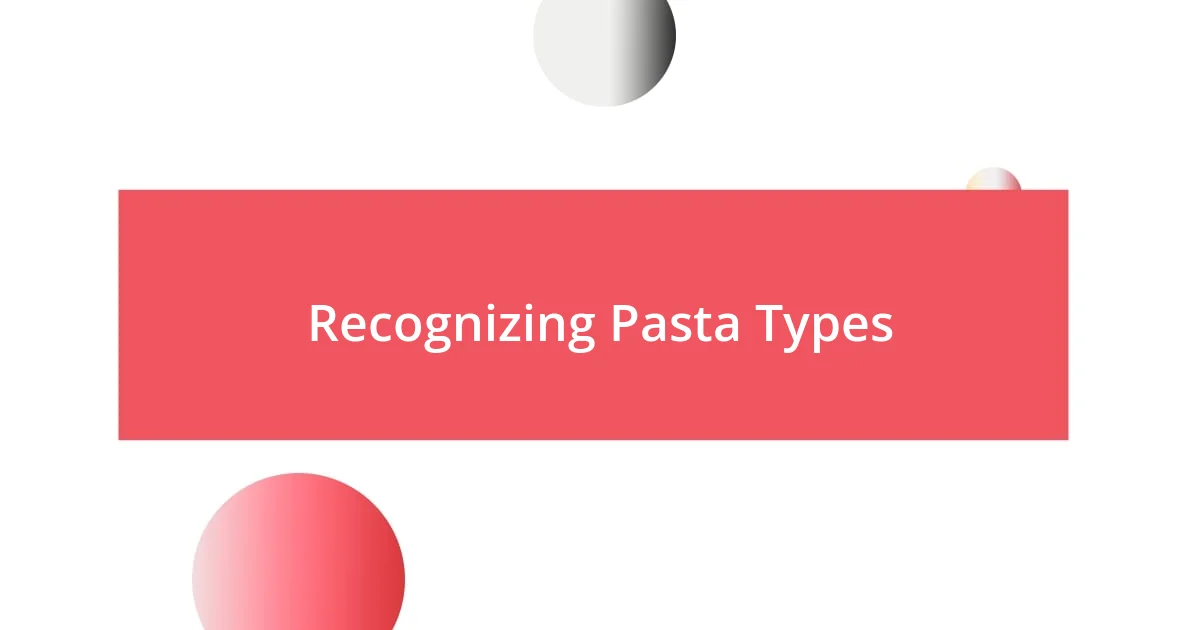Key takeaways:
- Pairing wine and pasta focuses on achieving harmony, considering the sauce and pasta type to enhance the overall dining experience.
- Regional wine pairings can elevate dishes, as wines often reflect local terroirs and complement traditional pasta recipes.
- Common pairing mistakes include oversimplifying wine choices, ignoring the balance of flavors, and not paying attention to serving temperature and glassware, which can greatly affect taste perception.

Understanding Wine and Pasta
When I think about wine and pasta, I often recall a memorable dinner my friends and I shared in an Italian restaurant, where the wine truly elevated the meal. The rich aromas from the wine melded with the savory pasta dishes, enhancing each bite and sip. It got me wondering: how can something as simple as a glass of wine create such a delightful pairing?
The connection between wine and pasta isn’t just about matching flavors; it’s about harmony. For example, a fresh tomato-based sauce can brighten a crisp white wine, while a hearty meat sauce finds its perfect companion in a full-bodied red. This synergy can transform a meal into a culinary experience, making you feel like a gastronomical connoisseur, even if you’re just enjoying dinner at home.
I love experimenting with different pairings, which have led me to discover my own preferences. Through trial and error, I found that a creamy Alfredo sauce with a buttery Chardonnay becomes a comforting embrace for the palate. It’s moments like these that make me appreciate the artistry behind both wine and pasta, and the joy they can bring to our dining experiences.

Recognizing Pasta Types
When I enjoy pasta, the type often determines not just the flavor, but also the wine that complements it. I remember one evening, trying to impress a date with homemade fettuccine. A moment of panic hit me when I realized the rice-based pasta called risotto required a different approach. Recognizing the subtle nuances of pasta types can enhance that pivotal pairing moment.
Here are some common pasta types and what to consider when pairing:
- Spaghetti: Classic and adaptable, often goes well with light reds like Chianti.
- Penne: This tubular pasta suits a variety of sauces and pairs nicely with a fruity Merlot.
- Fettuccine: Ideal for creamy sauces, and I’ve found a rich Sauvignon Blanc can lift the dish beautifully.
- Ravioli: Filled pasta like this makes for an interesting pairing; I once enjoyed it with a savory Pinot Grigio, complementing the delicate fillings.
- Orzo: Often used in soups or salads, pairs wonderfully with Chardonnays for a refreshing touch.
Learning to recognize these differences transformed my cooking adventures into a playground of flavors—every dish turned into an opportunity to learn and enjoy.

Matching Wine to Pasta Sauces
When it comes to matching wine with pasta sauces, the key is to listen to the characteristics of the sauce. For instance, I’ve often paired a vibrant marinara with a zesty Italian Pinot Grigio. The way the acidity in the wine cuts through the sweetness of the tomatoes creates a refreshing harmony that enhances the entire meal. I still recall an evening when I hosted friends, and this combination sparked a lively discussion about favorite pasta sauces and their ideal wines.
Rich, creamy sauces can present more of a challenge in pairing. During one festive gathering, I opted for a rich carbonara and was pleased with my choice of a light-bodied white like a Verdicchio. The wine’s crispness worked wonders against the creamy texture of the sauce, making every bite feel decadent yet balanced. It’s these kinds of experiences that teach me how well-chosen wine can elevate even the simplest dishes into something extraordinary.
For weightier sauces, such as a robust Bolognese, my go-to is a structured red like Montepulciano. I remember savoring this pairing on a rainy evening; the warmth of the wine complemented the dish’s heartiness perfectly. I often reflect on these moments, where it’s less about the rules of pairing and more about creating a sense of comfort and enjoyment at the dining table.
| Pasta Sauce Type | Recommended Wine |
|---|---|
| Marinara | Pinot Grigio |
| Carbonara | Verdicchio |
| Bolognese | Montepulciano |
| Alfredo | Chardonnay |
| Pesto | Sauvignon Blanc |

Selecting the Right Wine Styles
Selecting the right wine style can truly transform your pasta experience. I distinctly remember the first time I chose an aged Barolo for a hearty lasagna. The complex flavors of the wine melded beautifully with the layers of meat and cheese, leaving me wondering why I hadn’t tried it sooner. It’s moments like these that drive home the importance of pairing; the right wine can take your dish from ordinary to extraordinary.
When exploring wine styles, it’s essential to consider the wine’s body and acidity. A light, crisp white can brighten up a dish with lemony seafood pasta, while a velvety red can deepen the flavors of a meaty ragù. I once paired a zesty Vermentino with spaghetti alle vongole, and the invigorating freshness complemented the clams perfectly—an experience that made me cherish the simplicity of perfect pairings.
Don’t forget about the impact of regional pairings! Whenever I whip up a classic Italian pasta, I feel it’s only natural to reach for a wine from the same region. The day I discovered the magic of pairing Sangiovese with my homemade pappardelle was a revelation. It felt like a culinary hug, where every bite transported me to the sun-soaked vineyards of Tuscany. Ask yourself, how much more enjoyable could your meals be by simply tuning into the symphony of flavors that each wine style brings to the table?

Considering Region and Pairing
When considering regional pairings, I find it fascinating how the essence of a wine can reflect the terroir, or the unique environmental conditions of a specific area. I once prepared a dish of orecchiette with broccoli rabe and chose a lovely rosé from Puglia. The result was not just harmonious; it felt like a celebration of the region itself. Does the wine capture the spirit of the dish, or does the dish amplify the attributes of the wine?
Exploring different regions can lead to delightful discoveries. I remember a trip to Tuscany, where I fell in love with the local Chiantis. On a picturesque evening, I paired this ruby red with a homemade pomodoro sauce. The wine’s fruity notes enhanced the freshness of the tomatoes, and the whole experience was laced with sun-drenched memories. Isn’t it incredible how a wine can transport you back to a moment in time, merely through taste?
It’s also worth noting that certain pasta dishes are classically intertwined with their regional wines. For example, I once made a luscious creamy fettuccine Alfredo and instinctively reached for an Italian Chardonnay from Alto Adige. Trust me, the creaminess of the dish found a stunning partner in the wine’s subtly rich flavor—like two dancers moving in perfect sync. How often do we miss out on such magical moments by disregarding the regional connections? By embracing them, we not only enjoy amazing flavors but also celebrate the cultural heritage behind each sip.

Tips for Serving Temperature
When it comes to serving wine with pasta, temperature plays a crucial role in enhancing the tasting experience. For whites, I’ve found that chilling them between 45°F to 50°F (7°C to 10°C) allows their fruitiness and acidity to shine. I’ll never forget the time I served a chilled Sauvignon Blanc alongside a lemony pasta—it was like a refreshing breeze on a hot summer day, elevating each bite.
On the other hand, reds benefit from being served slightly cooler than room temperature, about 55°F to 65°F (13°C to 18°C). I remember pouring a Merlot to accompany a rich Bolognese sauce; the wine’s softer tannins unfolded beautifully at that ideal temperature. It’s fascinating how the right chill can turn an ordinary dinner into an unforgettable sensory journey, isn’t it?
Finally, don’t overlook the importance of letting your wine breathe after pouring, especially for heavier reds. I learned this lesson well when I tried a recently uncorked Cabernet Sauvignon without any air—yikes! It tasted muted. But after a short wait, the depth and complexity unraveled, complementing my robust pasta dish perfectly. Have you ever experienced the transformation that a little patience can bring? Embracing serving temperatures and allowing your wine to flourish truly enriches the overall dining experience.

Common Pairing Mistakes to Avoid
Pairing wine with pasta can be an amazing adventure, but there are common pitfalls to be mindful of. One huge mistake is assuming that all white wines go with all pasta dishes. I once made this error with a delicate seafood pasta, opting for a heavy oak-aged Chardonnay. The result? It overwhelmed the dish instead of enhancing it. The acidity of the wine got lost in the richness, turning my meal into a muddled experience.
Another frequent misstep lies in disregarding the balance of flavors. I distinctly remember pairing a spicy arrabbiata sauce with a bold red wine. While I thought the intensity would match, it was a clash rather than a dance. The wine’s tannins exacerbated the dish’s heat, leaving my palate feeling burned rather than delighted. Have you ever had a pairing that just didn’t click? Finding synergy is so important—it’s what makes a bottle of wine worthy of accompanying your favorite pasta.
Lastly, don’t underestimate the impact of serving size and glass choice on your pairing experience. I once poured a stunning Nebbiolo into a wide-bowled glass alongside a rich carbonara, thinking more air would help it shine. Instead, I ended up with an overly aromatic and disjointed pairing because the pasta’s creaminess demanded a more precise approach. Would you experiment with different glasses to see how the wine breathes? Sometimes, it’s the small adjustments that can elevate your dining moments from good to unforgettable.















